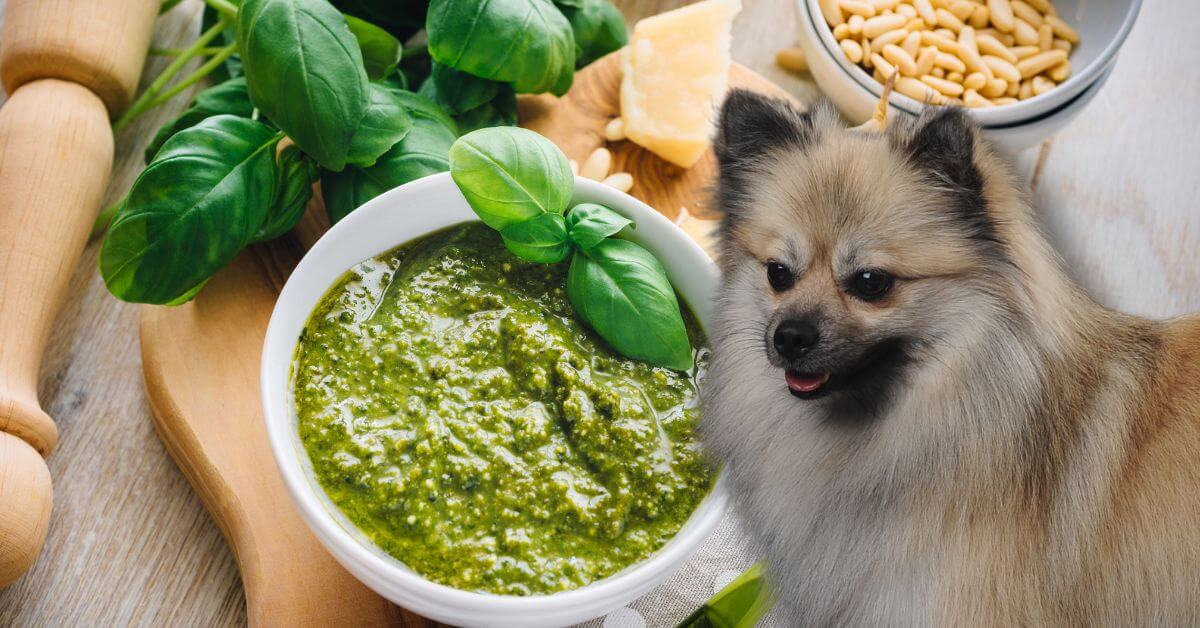Can Dogs Eat Pesto?
No, dogs can’t eat pesto. It can make them sick because it contains garlic, which is toxic for dogs in large amounts. Plus, pesto is high in fat, which isn’t good for dogs and can lead to digestive issues or pancreatitis. If you’re enjoying a meal with pesto, don’t share it with your dog. If they accidentally eat a bowl of pesto pasta, stay calm—they’ll most likely be okay. But remember, it’s best not to give them pesto on purpose.

What to do if your dog eats pesto?
If your dog eats pesto, the situation depends on their size and how much pesto they consumed. If they had a bowl of pasta with pesto, it’s less concerning than if they ate pure pesto directly from the jar. Pesto is made with garlic, which is toxic to dogs, but only in huge amounts! So don’t worry. If your dog really devoured an entire jar of pesto or more, here’s what to do:
Don’t worry too much, though—your dog would need to eat a significant amount of garlic to experience harmful effects. Garlic doesn’t affect dogs immediately; symptoms could take a few days to appear, as the red blood cells are not destroyed immediately. Signs of toxicity may include:
- Difficulty breathing
- Lethargy
- Change in gum color (pale, yellow, or muddy)
- Abdominal pain
- Elevated heart rate
- Painful abdomen
Remember, the sooner you act, the better the outcome for your dog’s health, but garlic poisoning is very rare, and it’s highly unlikely you’ll have problems with it. Still, it’s always better to be informed, and that is the whole purpose of this website.
Garlic toxicity in dogs is very rare
To soothe your mind, we’re sharing a study that we finally found on garlic and onion toxicity in dogs. It’s just a four-page PDF, so check it out! If you want a shortened version, here it is. According to the document, garlic toxicosis in dogs typically occurs after consuming a significant amount, either a large quantity at once or smaller amounts repeatedly. Specifically, the document states that onion toxicosis has been noted in dogs that consume more than 0.5% of their body weight in onions. For garlic, while it doesn’t provide a specific gram amount, it can be inferred that similar quantities would be necessary for toxicity to occur.
In practical terms, a dog would need to consume a relatively large amount of garlic to experience harmful effects. For example, a 30-pound dog would need to eat about 68 grams of onion (or similar amounts of garlic) to potentially reach a toxic dose. This information suggests that occasional, small accidental ingestions of garlic, like in pesto, are unlikely to cause severe toxicity, but caution and monitoring are still recommended.
Other than garlic, what else in pesto can harm dogs?
Pesto contains several ingredients that can be problematic for dogs. While a small amount used in cooking is unlikely to cause serious harm, it’s important to understand the potential risks.
Basil
Basil is generally safe for dogs in small amounts. However, in large quantities, it can cause gastrointestinal upset as it’s fiber, so a lot will make them sick. However, basil is perfectly fine.
Pine nuts
Pine nuts are high in fat, which is not healthy for dogs. But a few pine nuts won’t harm your dog, so don’t worry about it.
Olive oil
Olive oil is okay for dogs in moderation, but too much can cause diarrhea and weight gain due to its high fat content.
Parmesan cheese
Parmesan cheese contains high levels of salt and fat. Both are not food for dogs. While a small amount won’t cause salt poisoning, parmesan cheese is still not the best cheese for dogs.
Salt
Pesto often contains added salt. A lot of salt will make your dog thirsty and could lead to sodium poisoning in severe cases.
Lemon juice
Lemon juice is acidic and can cause upset stomach in dogs. While a small amount used in cooking is unlikely to cause harm, it’s best to avoid giving it to your dog directly.
A tiny amount of pesto used in cooking won’t harm your dog, but it’s best to avoid giving it to them. Ingredients like garlic, pine nuts, and Parmesan cheese are not that healthy in larger quantities. Always choose healthier, dog-friendly treats, and you can rediscover dog-friendly Italian cooking together!
Love, life, and fur forever!
FAQs
Can dogs eat basil pesto?
No, dogs shouldn’t eat basil pesto. While a small amount might not cause serious harm, the garlic and high-fat content can be dangerous for them.
Can dogs eat red pesto?
No, red pesto is not safe for dogs. It contains similar ingredients to basil pesto, including garlic and high-fat content, which can be harmful.
Can dogs eat pesto gnocchi?
It’s best to avoid giving dogs pesto gnocchi. The pesto contains ingredients that are not good for dogs, like garlic and high-fat content, which can cause digestive issues and other health problems.